by Bryan Burnett
Convincing evidence in a scientific paper by two forensic experts of the murder of Colonel James E. Sabow rejected by leading forensic journals.
(SAN DIEGO, CA) – This is Part II of the story of the forensic evidence supporting the murder of Marine Colonel James E. Sabow on the morning of January 22, 1991 at MCAS El Toro, CA. The pathology of the murder was written by Dr. John David Sabow, forensic neurologist and published earlier on VeteranToday.com. Part II and Part III cover the crime scene analysis .
The violent death of Marine Colonel James E. Sabow at MCAS El Toro on January 22, 1991, was a clear case of homicide. For those with knowledge of the cold case, this isn’t even a close call.At least that’s the view of many non-government experts who have reviewed the evidence, including Dr. John David Sabow, a board certified neurologist and practicing neurologist, and Bryan Burnett, a crime scene reconstructionist expert from San Diego.
A scientific paper submitted by Dr. John David Sabow, forensic neurologist, and me provides convincing evidence of homicide and support for ‘ a rush to judgment’ by the Orange County Medical Examiner. The OC Medical Examier found suicide as the manner of death. Dr. Werner Spitz, an internationally known pathologist, reported to the NCIS in 2011 that there’s considerable discrepancies between the written reports and the photographs, considerable doubt about the Coroner’s certification of death as suicide, and the certification of suicide was a rush to judgment based on erroneous assumptions. Dr. Spitz concluded that Colonel Sabow was murdered.
The Investigative Science Journal editor or the alleged reviewers (the editor never released the reviewers’ comments despite twice being requested for them) did not take the time to read the paper while the Journal of Forensic Science’s reviewers who “apparently had not read the manuscript came up with a criticism that was outrageous,” which resulted my filing a complaint with the Ethics Committee of the American Academy of Forensic Sciences (AAFS). The chairman of the Ethics Committee just before the AAFS meeting last year apparently decided on his own that the committee did not have jurisdiction in the matter. There was no comment on the issues presented by the reviewer’s comments.
My crime scene analysis of the violent death of Colonel James E. Sabow is presented below and in Part III to be published later this week:
Figure 1. Photographs from the death scene. A. The body in the backyard of his home. The shotgun is in front of him with his legs over the shotgun stock. A patio chair is on top of the body. B. Another view of the body. C. View of the victim’s legs and feet with the shotgun stock underneath. D. View of the body from the rear. The bathrobe was tucked between the legs at the buttocks.
A United States Marine Corps colonel died between 0835 and 0900 on January 17, 1991. The death occurred in the backyard of his home on the El Toro MCAS, Orange County, California.
The colonel was found lying on his right side dressed in a white terrycloth bathrobe, white undershirt, light blue pajama bottom, white socks and black slippers (Fig. 1). The death certificate, issued the next day, stated he had died by suicide. Death was alleged to be by an intraoral shotgun discharge. The close proximity of the victim’s shotgun (Ithaca 12 gauge double barrel shotgun) to his body as well as a patio chair on top of him support a suicide scenario. However, bloodstains away from the body, the autopsy report images, X-rays and the autopsy and death scene photographs indicate homicide. This report will examine the evidence and the reconstruct the events leading to the death of the colonel.
In 2003 Congressman Duncan Hunter, Chairman of the Armed Services Committee, was apprised of the controversy regarding the colonel’s death. In response, Congressman Hunter amended the United States Defense Authorization Bill for 2004 to include instruction to the Department of Defense for a reinvestigation of the death. The Department of Defense chose Jon Nordby to conduct the mandated investigation which resulted in a report (Nordby, 2004) submitted to the Congress.
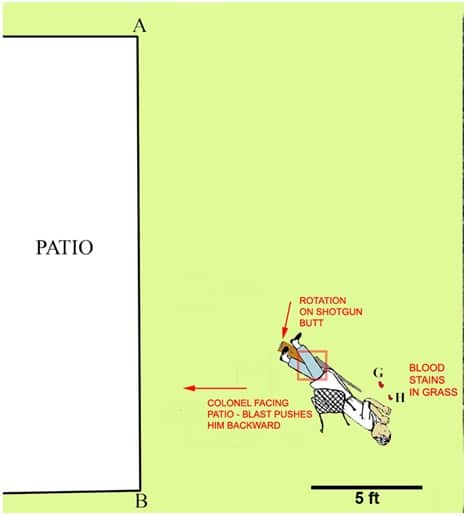
Figure 2. The death scene drawn to scale using the measurements provided by the Naval Investigative Service (NIS, 1991) on the scene drawing. The body graphic is the one originally rendered in the scene drawing, but sized and rotated to the scaled position. The grass bloodstain positions G and H were adjusted according to those measurements on the scene drawing and their positions are shown in relation to the body. Color was added by author. The scene is portrayed in the suicide scenario. The estimated original position of the patio chair (red square) in the suicide scenario is based on the shotgun pivoting on its stock to the location under the victim’s legs and feet, as shown with the colonel being “propelled” by the shotgun blast backward and to his right. In the suicide scenario, he somehow straightens his body.
The 2004 Nordby report, which concluded suicide, was not convincing. We conducted an independent study which resulted in an ad hock report to Congressman Duncan Hunter (Burnett & Sabow, 2007). I concluded the colonel died by homicide. The gunshot residue (GSR), back spatter residue (BSR), bloodstain examination and crime scene observations of that report are presented here. The death scene is illustrated in Fig. 2 which illustrates the suicide interpretation of the colonel’s death.
The two scenarios as to how the colonel died:
He committed suicide with his 12 gauge shotgun by sitting in a chair placing the shotgun in his mouth (Fig. 3A). The shotgun muzzle was held at his mouth with his left hand and he pushed the trigger with a finger or the thumb of his right hand. The position of the body (Figs. 1 and 2) suggests that consistent with this scenario, the shotgun was held outside his right leg and after the shot, he somehow fell backward from the chair and onto his right side causing the patio chair to upset and land on top of him (Fig. 2). This is the theory promulgated by Nordby (2004 and 2006).
He received a blow to the back of his head, which rendered a fatal injury. While the colonel was lying on the ground, the assailant inserted the victim’s 12 gauge double barreled shotgun into his mouth and fired the left barrel. This part of the scenario is reenacted in Fig. 3B. The shotgun waspositioned under the colonel’s legs and a patio chair placed on the body (Fig. 1) in order to generate the appearance of suicide.
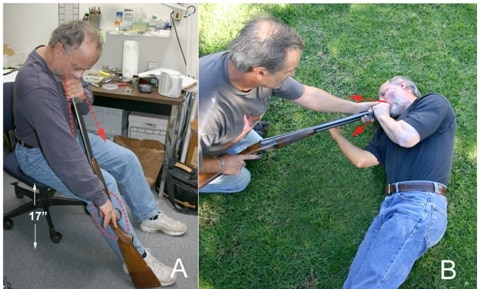
Figure 3. A. Reenactment of the suicide scenario with the victim sitting in a chair and inserting the shotgun into his mouth. The muzzle is gripped by the left hand while the right hand is at the trigger. The shotgun was found under the right leg (Fig. 1). This would place the shotgun in the reenactment on the outside of the right leg. In this scenario, gas escape from the mouth would spray the thighs (red arrows) with GSR, BSR and blood/tissue on the front of the bathrobe and/or the thighs of the pajama bottom. The red dashed line on the lower right leg outlines the probable area of GSR deposition if there were breech and trigger housing gas leakage by the shotgun. B. Reenactment of part of the homicide scenario where the shotgun is inserted into the mouth of the victim by the assailant. In order for the muzzle to remain in the mouth when the shotgun is fired, the stock of the shotgun would have to be supported. Evidence for a rapid exit (recoil) of the muzzle of the shotgun in this scenario is the rotation and drop to the grass of the left hand before receiving blowback blood (see text). The right hand was not exposed to detectable GSR. However, blood spatter is on the right hand which would also place this hand close to the nose and mouth, the only sources of blood shedding. The death scene photographs (Fig. 1) show the victim’s right hand near the mouth. Red arrows: route of the gas expellation (early blowback) while the shotgun muzzle was in the colonel’s mouth.
The paper by Sabow and Burnett (2011) examined the pathology in Part I of this series. Revealed in that study was evidence of a depressed right occipital skull fracture which was shown to have occurred prior to the intraoral shotgun discharge. The colonel had received a strong blow by a club to the back of his head prior to the intraoral shotgun blast. Part II of the study presented here examines the gunshot residue and back spatter residue (blow back particles from the intraoral shotgun blast) by scanning electron microscopy/elemental analysis. Part III will examine the bloodstains on and around the body, the position of the body and clothing and a reconstruction of the manner of death of Colonel James Sabow.
Gunshot & Back Spatter Residues
Particle types. Two general particle types involved in this case can be detected by scanning electron microscopy (SEM)/energy dispersive X-ray analysis (EDS):
Gunshot residue (GSR). The particles that are produced by the firing of a gun are usually composed of lead, antimony and barium in various combinations. These particles originate from the primer of the cartridge. Other elements that are occasionally found associated with GSR, are aluminum, silicon, sulfur, chlorine, potassium, calcium and iron. In addition, bullet-origin particles composed of copper, zinc and nickel are also produced and are often associated with the primer-origin particles. Unjacketed bullet and some jacketed bullets will produce large amounts of lead particles (Wolten, et al., 1977). For a shotgun, lead shot ablation coupled with heat would generate lead particles as they travel down the bore.
Back spatter residue (BSR). These are particles produced by a contact or near contact shot to the head included in blowback. The interaction of the bullet, or in this case, lead shotgun pellets and hot gases with bone (calcium and phosphorus) will produce characteristic particles of lead-calcium-phosphorus and particles composed of bone (Burnett, 1991). Gunshot residue particles might also be associated with BSR.
Leakage of GSR-laden gases from the shotgun, if it occurs, would be from the breech area and perhaps the trigger housing of the Ithaca shotgun (Fig. 4). There appear to be no published reports on GSR leakage of side-by-side double barrel shotguns. Once it was established that the shotgun has breech leakage of GSR-laden gas, the major part of the particle burden study is the examination of samplers taken from the colonel’s bathrobe and pajama bottom and examined by scanning electron microscopy/energy dispersive x-ray analysis (SEM/EDS).
Martinez (2000) notes, “…GSR can be readily detected and identified on clothing and in automobile interiors with the same simple sampling techniques as those used for collecting P-GSR [primer gunshot residue] from the hands. The results obtained proved to be a valuable investigative tool in reconstructing the possible events of firearms related crime and should not be overlooked by the forensic scientist.” Unfortunately, this viewpoint is not universally accepted. Contrary opinions have been proffered by criminalists in case work. For instance, in the case California v. Robert Blake (2005, Los Angeles, California), a criminalist stated in a memo when asked to analyze sweatshirts for GSR, “…explain to [the detective] that gunshot residue particle analysis cannot prove or answer his question. Any interpretation of the presence

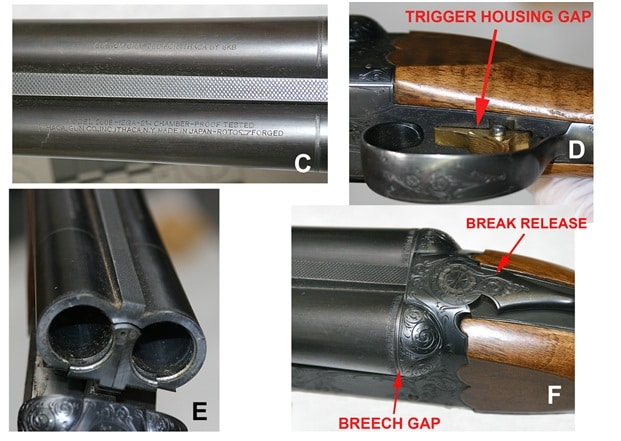 Figure 4. The shotgun. A. Full view of the Ithaca shotgun with the Winchester “Game Load” box and cartridges used in the test of the shotgun. B. The serial number of the shotgun. C. Identification information on the barrels of the shotgun. D. The trigger area of the shotgun. The trigger housing gap is indicated. E. The opened breech of the shotgun. F. The closed breech area of the shotgun.
Figure 4. The shotgun. A. Full view of the Ithaca shotgun with the Winchester “Game Load” box and cartridges used in the test of the shotgun. B. The serial number of the shotgun. C. Identification information on the barrels of the shotgun. D. The trigger area of the shotgun. The trigger housing gap is indicated. E. The opened breech of the shotgun. F. The closed breech area of the shotgun.
or absence of gunshot residue on surfaces other than bare hands is unfounded and possibly misleading” (Burnett, 2005A). In the case of California v. Philip Spector (2007, Los Angeles, California), another criminalist did not sample Spector’s jacket sleeves for GSR, even though Spector likely washed his hands prior to sampling. If one of Spector’s hands had been in close
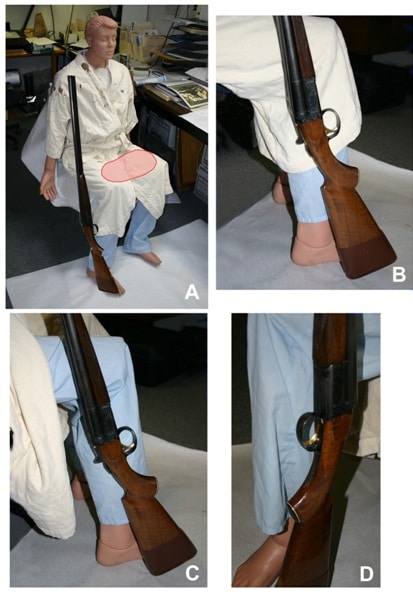 Figure 5. Reenactment of the suicide scenario with a mannequin wearing the victim’s clothes. A. Pink area: region where most of the back spatter in this scenario will hit the bathrobe. B. Close up of the mannequin’s right leg with the shotgun in place. C. As in B, but the bathrobe is off the right leg. In this scenario, the pajama right leg in the calf area would receive the breech and trigger-housing GSR. However, the body at the scene indicated that the bathrobe fully covered the leg. D. Another variation of the suicide scenario with the shotgun between the legs. This scenario is unlikely for the reason described in C and the scene photographs show the shotgun was positioned outside the right leg.
Figure 5. Reenactment of the suicide scenario with a mannequin wearing the victim’s clothes. A. Pink area: region where most of the back spatter in this scenario will hit the bathrobe. B. Close up of the mannequin’s right leg with the shotgun in place. C. As in B, but the bathrobe is off the right leg. In this scenario, the pajama right leg in the calf area would receive the breech and trigger-housing GSR. However, the body at the scene indicated that the bathrobe fully covered the leg. D. Another variation of the suicide scenario with the shotgun between the legs. This scenario is unlikely for the reason described in C and the scene photographs show the shotgun was positioned outside the right leg.
proximity to the revolver when it discharged, his jacket sleeve would have had GSR deposited on it. Discovery of heavy GSR deposition on one of the jacket sleeves would have been inculpatory (Burnett, 2007). Long-term persistence of GSR on clothing is known (Mann and Espinoza, 1993) and according to some criminalists, it cannot be establish that the shooting at issue was that which deposited GSR. However, the history of an article of clothing as to recent launderings and the probability of exposure to GSR from another source should be evaluated for any item suspected of involvement in a shooting.
Niemeyer (2000) described sampling and detection of GSR from the inside of a pocket where a recently fired pistol was secreted. There was no GSR detected on the sampler from the other pocket. Chavez, et al (1991) described the effect of washing GSR-contaminated clothing. Mann and Espinoza (1993) assessed contamination of bow hunter hands by jackets that were worn during rifle hunting. I have had cases over the last twenty-five years where the assessment of GSR burden on clothing and other inanimate objects had litigation value.
The suicide scenario would place the breech of the shotgun on the outside of the right leg (Fig. 5A) which would likely deposit GSR (if the shotgun’s breech leaks) on either the bathrobe (Fig. 5B) or the pajama bottom (Fig. 5C). In addition, the victim in the suicide scenario would be leaning slightly forward in order to prop the shotgun’s stock on the ground (Fig. 3A). In this position, blowback would occur quickly after the shotgun discharge and spray the front and lap areas of the bathrobe with GSR and BSR. Concentrations of GSR on the outside right leg and GSR and BSR on the front and lap of the bathrobe would be the hallmarks of suicide in this case.
In the homicide scenario (Fig. 3B), there would be no focal (heavy relative deposition) GSR deposited on the bathrobe since the shotgun breech would be away from the body and the blowback from the mouth would also be directed away from the body. However, wind transport of GSR (White and Gross, 1994) and BSR onto the bathrobe is possible. If deposition by wind did occur, there would be a pattern to the distribution of GSR on the bathrobe.
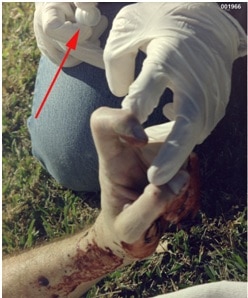
Figure 6. Photograph from scene showing the left hand of the victim in the process of GSR sampling. The arrow points to the GSR sampler. This is a “concentration technique” sampler made for SEM analysis, but was not analyzed. Swabs were also taken (no images) and analyzed by atomic absorption spectroscopy.
The GSR samplers taken from the hands of the colonel at the death scene. One of the two types of GSR samplers was used for the concentration technique (Zeichner, et al., 1989) and was photographed at the scene (Fig. 6). These samplers were apparently not analyzed. A video documentation of the scene processing by NIS criminalists showed swabs were also taken for GSR analysis after the SEM sampler sampling. The swabs were analyzed by atomic absorption spectroscopy (AAS). The procedure was performed at the California Department of Justice Laboratory in Riverside, California. The report (Anon., 1991) indicated that there were four swab samplers, two for each hand, back and palm.
Analysis for GSR and BSR. The GSR and BSR burdens associated with the bathrobe and perhaps the pajama bottom would differ depending on suicide or homicide of the colonel.
Analysis question one. Does the shotgun produce any (GSR-laden) gas leakage at the breech and from the trigger housing when fired? Before evaluating the second and third questions, there needs to be verification that the 12 gauge shotgun produces breech GSR when fired. There are two areas in the shotgun where gas-laden GSR might contaminate the shooter: through the trigger housing (Fig. 4D) and the breech (Fig. 4F) .
Analysis question two. With the confirmation that the shotgun has breech/trigger housing leakage, a suicide scenario (Fig. 3A) for the death of the colonel would be supported by the detection of a large relative amount of GSR on the bathrobe corresponding to the lateral right calf region (Figs. 5A and 5B) or the same region on the pajama leg (Fig. 5C). The shotgun placed between the legs (Fig. 5D) in this scenario is unlikely, but is the position hypothesized by Nordby (2006). The positions of the bathrobe on the body of the colonel and the shotgun (Fig. 1) suggest if this was a suicide, the shotgun would be lateral to the right side of the body at the time of discharge. Considering the position of the body and the shotgun, the simulations depicted in Figs. 3A and 5A are the most likely for the suicide scenario. Thus, GSR should have been deposited on the bathrobe corresponding to the dashed outlined area depicted in Fig. 3A and the same area in Fig. 5A. If the bathrobe was away from the pajama legs, a heavy GSR burden would be on outside right pajama leg (Fig. 5C). Are there such concentrations of GSR on the bathrobe or pajama bottom of the colonel?
Analysis question three. In the suicide scenario, the major exit for the gas in blowback is the sides of the mouth around the barrel of the shotgun and to lesser extent the nose. The exiting gases from the mouth and nose (red arrows, Fig. 3A) would be directed onto the front of the bathrobe and likely produce a heavy deposition of GSR and BSR on the thigh areas of the bathrobe (pink area of Fig. 5A) or the pajama bottom of the victim (if the bathrobe did not cover this area, as shown in Fig. 5C). In a homicide scenario, the exit of the gas from the mouth would be away from the body (Red arrows, Fig 3A). Do the thigh areas of the bathrobe or the pajama bottom lap areas have BSR and GSR burdens?
The shotgun tests. The left barrel of the Ithaca 12 gauge shotgun was used in all tests. The ammunition used in the shotgun at the time of the victim’s death was unavailable. Similar ammunition was obtained for the tests.
Shotgun breech/trigger housing leakage. The first test of the shotgun was to determine if the breech and the trigger housing leaks GSR. A series of tests to detect breech and trigger leakage of the Ithaca shotgun were performed. The leaking of gunshot residue from both the breech and trigger housing during the firing of the Ithaca shotgun was confirmed in two of those tests. The third test series was to determine if GSR deposition of the shooting hand varied (i.e., directional deposition) with an oblique finger or thumb depression of the trigger (as would occur if this were a suicide, Fig. 3A).
It was apparent from the results of the analysis of the samplers that GSR-laden gas emanates from the breech and trigger housing (www.meixatech.com/BURNETT&SABOW.pdf). In normal firing of the shotgun, the forefinger would be entirely across the trigger (Fig. 3B). But in the suicide scenario, the finger or thumb would approach the trigger obliquely (Fig. 3A) and there might be only partial exposure to the GSR laden gases from the breech area of the shotgun. Could the lack of detected GSR on the right hand be due to a non-uniform release of GSR-laden gas from the trigger housing?
In the final test of this series, two persons were required: one to hold the shotgun and the other to depress the trigger. Just after placing the polyester glove on the shooter’s hand (only the wrist edges of the glove were handled), 60 dabs of the glove surface were taken with the sampler. The ventilation system of the range was not working. The glove was quickly collected after each shot (turned inside out from the wrist during the removal) and placed in a plastic bag for later sampling. Three samples were taken from hands where the trigger was depressed obliquely:
The results of those analyses indicate that regardless of the position of the hand and fingers in the depression of the trigger, GSR deposition occurs upon firing the shotgun.
The DCI Forensic Laboratory of South Dakota also tested the Ithaca shotgun in the position as depicted in the suicide scenario (i.e., the muzzle directed up, as shown in Figs. 3B and 5A). This was done at an outdoor range. A clean cloth glove was used for each test, in which the trigger was depressed by the normal position and four tests were made by oblique pressing of the trigger with either the forefinger or thumb of the right hand. The report (Maritz, 2006) for these tests noted a wind speed of approximately 12 MPH during the tests.
Sampling and testing of the bathrobe and pajama bottom for GSR. The samplings of the bathrobe utilized GSR samplers as noted above. Nine GSR samplers, K-1 through K-9 were applied, 60 dabs per sampler per region of the bathrobe (Fig. 7A). Nine GSR samplers, H-1 through H-9 were applied, 60 dabs per region, on the pajama bottom (Figs.7B and 7C).
The samplers were examined by automated SEM at 180X at the laboratory of Dr. Jozef Lebiedzik. As much as 40% of each sampler surface was scanned. The results of Dr. Lebiedzik’s analyses are presented in Tables 1 and 2.

Figure 7. SEM sampler series H and K. Sixty dabs per sample. A: Sample regions of the bathrobe (samples K-1 through K-9). B: The front areas of the pajama bottom (Samples H-1 through H-6). C: The back of the pajama bottom showing the SEM tape lift area H-7 (buttocks), H-8 (left rear thigh) and H-9 (right rear thigh).
A second series of analyses of the K samplers, independent of the first series was performed by Dr. Lebiedzik. During the first analyses of the K samples, he noted that cotton fibers picked up along with the inorganic particles were charging. This caused electron beam deflection and particles were likely missed. The K samplers were carbon coated and six of these samplers reanalyzed. Included in the second series of analyses are assessments of calcium-phosphorus (CaP – bone) , lead-phosphorus (PbP – the geochemical end-point for soil lead) and lead-phosphorus-calcium (PbP Ca – bullet/shot lead + bone). The latter particle type, is a characteristic product of contact/near contact gunshot to a head that is found in the resultant back spatter (Burnett, 1991).
Results and discussion of the GSR and BSR tests.
Gunshot residue samples of the victim’s hands at the scene. Gunshot residue sampling of the victim’s hands was performed at the scene. It was apparent from the GSR report (Anon., 1991) that atomic absorption spectroscopy (AAS) was used to analyze these samples. A criticism of the AAS technique, which ultimately led to it to no longer being used for GSR analysis by crime laboratories for this application, is that elemental associations cannot be determined and automated SEM/EDS is more sensitive (Romolo and Margot, 2001). A video taken during the scene processing showed the criminalist, after dabbing the victim’s hands with concentration-technique GSR samplers, swabbed the same hand areas with cotton-tipped applicators. It was these applicators that were analyzed by AAS for GSR metals. The reliability of this procedure (dabbing followed by swabbing) for the swab-AAS testing has never been tested. It is possible the right hand had been contaminated with GSR, but the dabbing with the GSR SEM samplers prior to the swabbing had removed most of the GSR so that none was detected on the right hand. The soot areas on the left hand were sampled by both sampler types.
In both the suicide scenario (Fig. 3A) and homicide scenario (Fig. 3B) show the right hand’s probable exposure to GSR: the suicide scenario by breech GSR and homicide scenario by early blowback.
The results from the report (Anon., 1991):
“The gunshot residue collection kit from Sabow was analyzed for the elements antimony and lead by atomic absorption spectrophotometry. These elements can be found in gunshot residues. Very high levels of antimony and lead were found on the palm and back of the left hand samples, while samples from the right hand were negative. This could be due to the left hand being near the muzzle of the discharging shotgun.”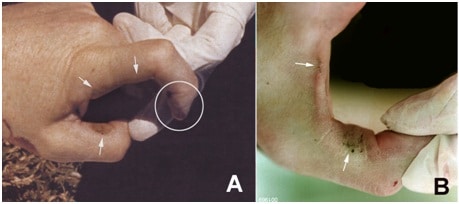
Figure 8. Gunshot soot (arrows) on the left hand of the colonel; photographs taken at the scene; the tip of the index finger shows a patterned bloodstain (circle).
The positions of the left and right hands at the shotgun blast. In both scenarios presented, the left hand gripped the barrel near the muzzle at the victim’s mouth when it fired. In the suicide scenario, the colonel gripped the shotgun himself in the manner shown in Fig. 3A. In the homicide scenario, the victim’s left hand was held in the same position on the shotgun’s muzzle by the assailant as shown in Fig. 3B. The presence of soot on the left hand (Fig. 8, arrows) means a heavy burden of muzzle GSR was deposited when the shotgun fired. Indeed, GSR was reported present on the left hand (Anon., 1991). The shotgun muzzle remained long enough in the victim’s mouth that “minute amounts of tissue blowback within the barrels” (NIS, 1991) was observed.
Even though the scene photographs of the body (Figs. 1A, 1B and 8) show the right hand just behind the left hand which in this configuration, the left hand would block blowback to the right hand. However, in the homicide simulation (Fig. 3B) the left hand was lifted so that the right hand probably received muzzle GSR in early blowback. It is apparent the left hand blocked deposition on the right hand for the bloody blowback (see Part III). Early blowback occurred mostly through the sides of the mouth when the shotgun was momentarily present (recoil pulled the shotgun muzzle out of the mouth) which was when the right hand was exposed to GSR in the homicide scenario. The left palm also likely received soot which was subsequently covered by blood-laden blowback after the rapid withdrawal of the shotgun from the mouth (see Part III). No GSR was detected on the right hand, which was likely due to a flawed sampling procedure and low sensitivity technology (AAS) compared to SEM/EDS.
Breech and trigger-housing leakage. The shotgun has breech and trigger-housing leakage. This was determined in this study and the tests performed by the DCI Forensic Laboratory and analyzed by the RJLee Group (Schwoeble, et al., 2006).
The nature of close-range shots to heads. The evidence presented in this case shows two distinct events occurred with the intraoral shotgun discharge. DiMaio (1999: Figure 5.4, p. 129) notes with a contact or near contact to a head that there is often a dissection (gas-filled void) between the scalp and the skull. This is followed by collapse of this space which results in initial blowback. But, in this case the shotgun blast was intraoral. The oral cavity is analogous to the temporary cavitation described by DiMaio (1999). There appears to be little difference between intraoral and scalp/skull early blowback and early intraoral blowback, except the former might have more tissue components involved in the blowback.
The second event is an “exhalation” of the gas that was injected into the skull by the gunshot, which follows and transitions from the initial or early blowback. This is likely especially true when there is no exit wound (Burnett, 1991). More organic debris (blood and other tissue) is associated with the second event in this case than the first. The present study shows that the intraoral 12 gauge shotgun blast without an exit wound presents the early blowback phase that is mostly made up of soot and GSR (Fig. 8 and see Part III). This transitions into a second phase blowback of gas with blood, other tissue debris, BSR and GSR. Evidence for a two-phase blowback from the victim will be discussed Part III.
The bathrobe and pajama bottom. The results of the analyses presented here and by the RJLee Group (Schwoeble et al.,2006) indicate that the shotgun leaks GSR when fired.
The results of the analyses by Dr. Jozef Lebiedzik of the eighteen tape lifts from the bathrobe and pajama bottom are presented in Table 1. For the bathrobe (the K samples) only two characteristic (PbSbBa) particles were detected (Table 1). The lead-only particles represent a significant problem in GSR interpretation due to many possible environmental sources, including piston-engine aircraft exhaust (the colonel’s house was in the flight path of the El Toro MCAS runway). So, the levels of “lead-only” particles found associated with the bathrobe cannot be attributed solely or even partly to the shotgun blast unless those levels are compared with samplers of articles of clothing that could not have been exposed to GSR.
The calcium-phosphorus (actually calcium phosphate) or bone particles on the bathrobe (Table 3) may be from blowback. But ground bone, “bone meal,” is used as a fertilizer additive. The association of lead with calcium phosphorus would have been created by the blowback event. The lack of lead-associated calcium-phosphorus particles indicates the calcium phosphorus particles identified in these analyses are from an environmental source.
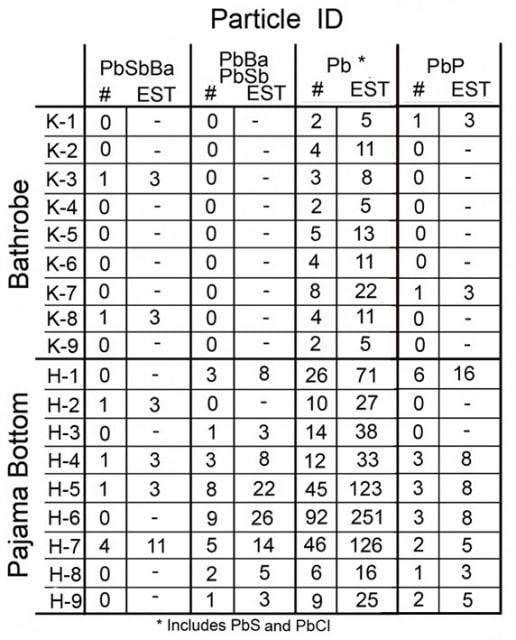
Table 1. Results of the automated SEM/EDS analysis of the samples from the bathrobe (K samples) and the pajama bottom (H samples); samples analyzed by Dr. Jozef Lebiedzik. “#” = number of particles; “EST” = number particles estimated on the entire sampler surface. Pb = lead, Sb = antimony, Ba = barium, S = sulfur, Cl = chlorine,
Table 2. Results of the second analysis series performed by Dr. Lebiedzik for six of the K samples from the bathrobe is shown; along with the second analysis series, calcium-phosphorus (CaP), lead-phosphorus (PbP) and lead-phosphorus-calcium (PbP Ca) burden were assessed. See text for additional information. “#” = number of particles; “EST” = number particles estimated on the entire sampler surface.
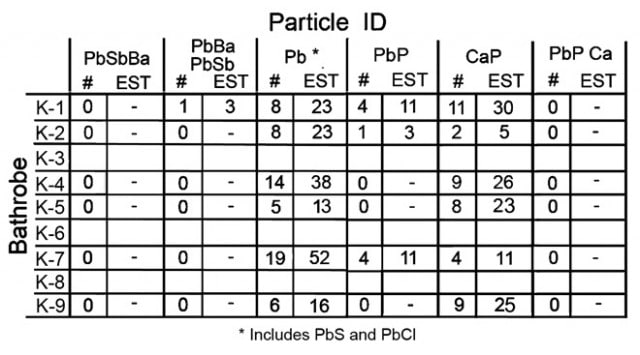 The lead-phosphorus particles have a quite different origin. These particles are the endpoint of the geochemical transition of soil lead (Cao et al., 2003). The presence of lead-phosphorus particles on the bathrobe indicate these and other lead-bearing particles, without antimony or barium association, have an environmental source.
The lead-phosphorus particles have a quite different origin. These particles are the endpoint of the geochemical transition of soil lead (Cao et al., 2003). The presence of lead-phosphorus particles on the bathrobe indicate these and other lead-bearing particles, without antimony or barium association, have an environmental source.
The estimated GSR burdens from the pajama bottom samplers are different from the bathrobe (Table 1). These samplers document an exposure to GSR of the pajama bottom the bathrobe did not receive. The two-component GSR (lead-antimony and lead-barium) particles are generally present on the pajama bottom, but only one particle of this type was found on the bathrobe. There are also more of the characteristic (PbSbBa) particles on the pajama bottom than on the bathrobe. The lead-only particle burden of the pajama bottom is also large compared to the bathrobe. The assumption in the comparison of the GSR burdens of these two articles of clothing is that both have nearly identical exposure histories prior to the shotgun blast and the pajama bottom was not contaminated by the other clothing items (underwear and t-shirt) that shared the same storage container.
The suicide scenario shotgun position (Fig. 3A) proposes that the colonel fell back and to his right off the patio chair following the intraoral shotgun blast (Nordby, 2004 and 2006). During the fall from the patio chair, the shotgun pulled from his mouth and the stock ended up beneath his legs and feet. He somehow straighten his body. The body position will be discussed in more detail below. The position of the shotgun in relation to the body suggests it was against the right leg as shown in Fig. 3A at its firing. The scene photographs also show the victim’s bathrobe tucked between his legs (Fig. 1A and see Part III). Thus, for the suicide scenario, the bathrobe would have to be covering the colonel’s legs and intercept the GSR from both the breech and the trigger housing at region K-9 (Fig. 7A).
In the suicide scenario, with the bathrobe covering the victim’s legs to its full extent as shown in the scene photographs, (Figs. 1 A and 1B), at least the areas K-6 and K-7 (Fig. 7A) should have evidence of extensive contamination by blowback (back spatter) of both GSR and BSR. No particle burdens supportive of this event were observed.
The GSR evidence of the bathrobe and the pajama bottom show:
1)The bathrobe was not in a position to become contaminated with GSR and BSR when the shotgun was discharged. The GSR contamination of the pajama bottom versus the bathrobe, means that the bathrobe was shielded from GSR contamination. The bathrobe was likely partly folded. turned inside out and “hiked up” on the victim so that the bathrobe was not contaminated with GSR when the shotgun was fired. The bathrobe likely covered little, if any, of the pajama bottom when the intraoral shotgun blast occurred. This indicates the bathrobe was in a different position when the shotgun was fired and the colonel’s body was manipulated (staged) postmortem.
2) The pajama bottom, because of the lack of cover by the bathrobe, was contaminated with GSR particles (Table 1). Curiously, one of the heaviest GSR contaminations was the buttocks region (sample H-7, Fig. 7C) of the pajama. This may have occurred due to the GSR-laden cloud from the shotgun blast drifting over the lower abdomen area or contact was made by the GSR-contaminated assailant (homicide scenario). The pajama covering the lower abdomen was not sampled. Regions H-4, H-5 and H-6 (Fig. 7B) also had relatively heavy GSR contamination. These three regions of the pajama bottom were apparently also exposed to the shotgun-produced GSR cloud when it discharged from the colonel’s mouth and/or the shotgun’s trigger housing and breech. With the victim lying on his right side in the homicide scenario, regions H-1 and H-3 would receive less surface exposure to GSR contamination. Indeed, these areas show less contamination than H-5, H-6 and H-7. The back of the thighs of the pajama bottom (H-8 and H-9) were shielded from the GSR source and received the least contamination. Alternatively, the pajama became contaminated in the areas that contain GSR particles when the shooter, with GSR-contaminated hands, participated in the staging of the body.
In the suicide scenario, the thighs of the bathrobe or perhaps the pajama bottom would be heavily contaminated with GSR and BSR, which was not the case for either item.
However, Nordby presented a report (2006) to the United States Department of Defense and Congressman Duncan Hunter, Chairman of the Armed Services Committee in 2006 which refutes the first report on GSR in this case (Burnett, 2005B) and the conclusions of this paper. Gunshot residue burdens without support data or images from of the colonel’s clothing were briefly discussed in two of the pages from Nordby (2006) which include the hand-drawn and written figures shown in Fig. 9. Nordby apparently used x-ray fluorescence (“XRF,” in the handwritten notes, Figs. 9A and 9B) to detect lead, antimony and barium. He reports observing
 Figure 9. Drawings and handwritten notes demonstrating the results of Nordby’s GSR testing of the bathrobe and pajama bottom (from Nordby, 2006). Portions of the figures are illegible in the source. A. Nordby’s drawing of the bathrobe where he indicates he had found GSR concentrated along the lower front hem (shaded area). The lower margins of the bathrobe were enhanced by adding gray to the areas originally shaded, but lost in the copying. B. A similar drawing of the pajama bottom; a concentration of GSR was discovered by Nordby on the front cuffs of the bathrobe.
Figure 9. Drawings and handwritten notes demonstrating the results of Nordby’s GSR testing of the bathrobe and pajama bottom (from Nordby, 2006). Portions of the figures are illegible in the source. A. Nordby’s drawing of the bathrobe where he indicates he had found GSR concentrated along the lower front hem (shaded area). The lower margins of the bathrobe were enhanced by adding gray to the areas originally shaded, but lost in the copying. B. A similar drawing of the pajama bottom; a concentration of GSR was discovered by Nordby on the front cuffs of the bathrobe.
0.5 to 10 micron diameter GSR particles, which must have been by SEM/EDS. Of Nordby’s alleged 285-page report, only the first 28 pages were available despite a number of requests for the entire document.
Nordby (2006) attributes his finding of GSR on the bathrobe lower hem and pajama bottom cuffs to the discharge of the shotgun between the colonel’s legs (Fig. 5D) rather than on the lateral side of the right leg (Figs. 3A, 5A and 5B) as would be indicate by the position of the shotgun with the body (Fig. 1) in the suicide scenario. However, his conclusion is consistent not with the suicide scenario, but with the homicide scenario where the assailant shooter handled the bathrobe and pajama bottom at these locations while staging the body (see below). If the shotgun breech was positioned near either the bathrobe or pajama bottom between the colonel’s legs (Fig. 5D) as suggested by Nordby, GSR should have been detected in areas H-5 and H-6 of the pajama bottom (Fig. 6B, Table 1). Although GSR from pajama bottom region H-6 was detected (Table 1), it is not in sufficient quantity to have been deposited by the closely-associated Ithaca shotgun breech.
Figure 5D shows just how untenable Nordby’s suicide scenario is with the shotgun placed between the colonel’s legs:
1. The bathrobe’s lower hem (Fig. 9A) simply would not be exposed to the shotgun breech (Fig. 5D) since it would be impossible for the bathrobe to cover the inner legs as would be necessary to be exposed to the shogun’s breech discharge.
2. The shotgun’s breech is too high on the pajama pant legs in the suicide scenario (Fig. 5D) to have deposited GSR at the locations shown in Fig. 9B.
For Nordby’s GSR deposits to be missed in the study presented here, the sampling described in the present study was apparently above those GSR deposits found by Nordby. The only way for Nordby’s GSR deposits to have occurred and be consistent with the results presented in Tables 1 and 2 is for the GSR-contaminated shooter to have participated in the staging of the colonel’s body in the homicide scenario.
The references cited above will be included with Part III.

Robert O’Dowd served in the 1st, 3rd and 4th Marine Aircraft Wings during 52 months of active duty in the 1960s. While at MCAS El Toro for two years, O’Dowd worked and slept in a Radium 226 contaminated work space in Hangar 296 in MWSG-37, the most industrialized and contaminated acreage on the base.
Robert is a two time cancer survivor and disabled veteran. Robert graduated from Temple University in 1973 with a bachelor’s of business administration, majoring in accounting, and worked with a number of federal agencies, including the EPA Office of Inspector General and the Defense Logistics Agency.
After retiring from the Department of Defense, he teamed up with Tim King of Salem-News.com to write about the environmental contamination at two Marine Corps bases (MCAS El Toro and MCB Camp Lejeune), the use of El Toro to ship weapons to the Contras and cocaine into the US on CIA proprietary aircraft, and the murder of Marine Colonel James E. Sabow and others who were a threat to blow the whistle on the illegal narcotrafficking activity. O’Dowd and King co-authored BETRAYAL: Toxic Exposure of U.S. Marines, Murder and Government Cover-Up. The book is available as a soft cover copy and eBook from Amazon.com. See: http://www.amazon.com/Betrayal-Exposure-Marines-Government-Cover-Up/dp/1502340003.
ATTENTION READERS
We See The World From All Sides and Want YOU To Be Fully InformedIn fact, intentional disinformation is a disgraceful scourge in media today. So to assuage any possible errant incorrect information posted herein, we strongly encourage you to seek corroboration from other non-VT sources before forming an educated opinion.
About VT - Policies & Disclosures - Comment Policy




